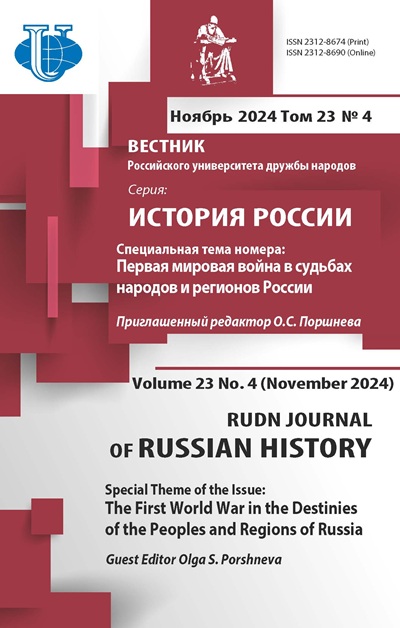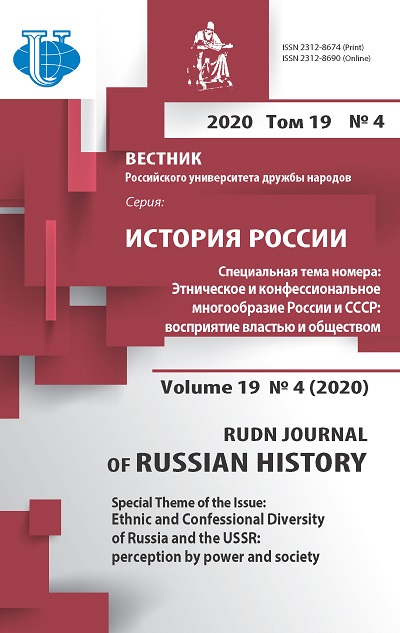Full text / tables, figures
This issue explores ethnic and religious diversity in Russia and the USSR. Ethno-confessional relations are an important aspect of the history of multinational states.
The Russian Empire and the USSR were no exception, and their governments often considered the matter in both their domestic and foreign policy. Studying ethnic and confessional interaction at different stages in the history of our country is necessary for a better understanding of social and cultural relations among its many nationalities.
V.S. Blokhin’s article looks at the conversion of Orthodox believers to Armenia’s Gregorian faith in the Russian Empire during the 19th and early 20th centuries. He explains that this had been a criminal offense before the decree “On strengthening the principles of religious tolerance” of 1905. However, after its approval, the laws were adjusted to approve conversion from Orthodoxy to other Christian confessions.
V.P. Litvinov considers the long neglected question of the sheikh custodians of Central Asia’s holy places. The author points out that under Islamic rule they were never legally recognized, even though the practice of maintaining sacred objects was widespread throughout the Muslim world, including the cradle of Islam – Arabia. Historically, in Central Asia they were largely funded by waqf, or charitable endowments, not merely by the donations of pilgrims. After the region came under Russian rule in the second half of the 19th century, the new authorities tried to regulate their activity, but were discouraged by the local Islamic population’s hostility.
The article by Yu.A. Lysenko and M.N. Efimenko examines the Orthodox Mission to the Kyrgyz of the Orenburg region at the turn of the 20th century. Its authors explain that the Russian Orthodox Church tried to institute missionary activities there to resist Islam, but the Orthodox community was too small, while the predominance of Old Believers among the Christian population greatly hampered their efforts. Moreover, the “Kirgization” of Russians forced the missionaries to limit their proselytization to settled Orthodox peasants. Nevertheless, they established a system of missionary education that halted rising apostasy from Orthodoxy.
O.V. Erokhina and O.A. Litzenberger analyze the legal framework of Russian resettlement from the German states to the empire’s south. As they point out, this was carried out to develop the frontier and introduce modern agricultural practices there. At the same time, the authors note that the lack of an effective mechanism for resettlement as well as inattention to its consequences initially caused many problems, but the authorities eventually resolved these shortcomings.
I. Vladimirsky and M.V. Krotova discuss the “Jewish question” in Eastern Siberia in the early 20th century through the life of the wealthy Irkutsk gold miner Yakov Frizer. They conclude that, compared to central and southern Russia, ethno-confessional relations in the region were more democratic and less restrictive. The authors attribute this to the special circumstances of Siberia’s development, which made it easier for Jews successfully integrate into society there.
An interesting article by V.N. Shaidurov and T.A. Novgorodsky provides the first study of relations between the Russian state and Roma in the second half of the 18th and the first half of the 19th centuries from the perspective of recruitment for military service. As the authors note, only a small number of Roma were affected. This leads them to conclude that the Tsarist regime was unable to develop an effective mechanism for integrating the Roma into its institutions.
A.V. Chernykh and M.S. Kamenskikh continue the theme of efforts by the state to integrate its Roma by analyzing Soviet policy during the 1920s and 1930s in the Ural region. They explain that, the young Soviet state carried this out more effectively than before the Revolution. However, it did not take into account the region’s specifics, resulting in often impulsive and erratic implementation, which led to many failures.
These articles all enhance our understanding of how Russia’s nationalities coexisted. The need to study the history of ethnic and confessional diversity in Russia and the USSR is necessary to understand current developments, especially as the former Soviet Union’s newly independent states mobilize nationalism to strengthen the loyalty of their citizens. The contributions to this issue are distinguished by their originality, research, and interesting content. We are confident that they will appeal both to scholars and the general public.
About the authors
Bunin Yelets State University
Author for correspondence.
Email: vladlenli@yandex.ru
Doktor Istoricheskikh Nauk [Dr. habil. hist.], Senior Research Fellow, Scientific Research Laboratory
28/1, Kommunarov St., Yelets, 399770, Russia
















